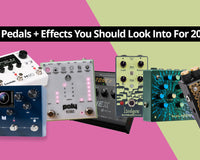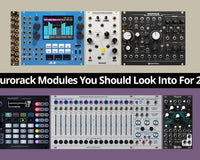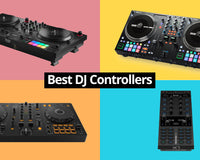Modular synthesis is a deep and intricate subject. Modular synthesizers can produce infinite sonic possibilities that go beyond what’s possible with a typical hard-wired synthesizer. That being said, it should be no reason to scare you away from exploring these possibilities.
Four years into my modular synth journey, there is still so much I am learning every day, and that is mainly why I am so excited to continue my explorations.
There are many considerations to make when first introducing yourself to the world of modular synthesis. Let’s dive in and begin figuring out how you can get started.
WHAT ARE YOUR GOALS?
As a starting point, I always find it best to ask: what are your goals? Are you looking to:
- expand your sound by exploring the infinite timbres of synth design?
- have more control over synth parameters, and the ability to modulate everything?
- just have a robot companion to jam with?
With the wide variety of synth modules out there, it will be a good idea to assess your goals and figure out which modules will help you achieve them. There is some overlap between modules, but you will need different hardware if you plan on just exploring timbre than if you are looking to sequence patterns to perform overtop of. Your goals may change over time as you learn more. You may change direction in your artistic journey. Having a good starting point will at least make it easier to begin your adventure.
STARTING WITH SOFTWARE
Modular synthesis requires an investment of both time and money. Luckily, there are ways you can get started with without purchasing any hardware. This will allow you to see if the workflow is right for your goals, and you can even try out certain types of modules before making a commitment to buying them.
I started my journey with Reaktor Blocks by Native Instruments. Blocks runs inside NI’s Reaktor plugin (included in NI Komplete), and is regarded as a perfect starting point for people who want to dip their toes into modular synthesis. Blocks allows you to create custom synthesizers by using their library of modules in an easy, drag-and-drop approach, where you can connect Blocks together in a similar fashion to how you would with physical synth modules in case. It comes with tutorial presets for you to get a hang of the interface and start creating your own sounds right away.
Since it is hosted within Reakor, it is very simple to run inside your DAW and receive MIDI CC data from your controllers or modulation lanes. Blocks automatically syncs with your DAWs clock, can be sent audio from other instruments, and you can control the volume, pan and sends as you would with any other channel strip.
NI is offering a free 24 pack of blocks called BLOCKS BASE to get you started.
After Blocks, I moved on to VCV Rack. VCV is a free, open source, cross-platform app where you can emulate eurorack modular synthesis. VCV rack aims to be a realistic representation of how you work physically with modular synths. You assemble modules on a virtual rack and all the in/out jacks are visible on the front panels. VCV rack comes with a collection of stock plugins and you have access to their library of expansions.
VCV Rack can be connected to your DAW via VCV Bridge - this works as a channel strip plugin that transmits audio and MIDI between the standalone VCV Rack app and your DAW. VCV Rack is a popular app and there are thousands of tutorials online to help you get acquainted with this software. A big popularity factor for VCV is that it gives users access to emulations of modules by companies like Mutable Instruments to try out before purchasing.
A good thing about both Blocks and VCV is that you can use them to communicate with hardware synthesizers, so once you take the plunge into physical synth modules you will still find Blocks and VCV useful in your music creation.
VCV Rack interface
SEMI-MODULAR SYNTHS
Although it isn’t mandatory, a great starting point for modular synth hardware is to get a semi-modular unit. These synths are set up to work right away without any patching, but give you access to synth parameters and modulation sources via jacks, just like fully modular synth hardware. Along with the patching you can do within the single semi-modular system itself, this also opens up the possibility of interfacing with other semi-modular synths or fully modular synth modules.
Many semi-modular synths come with keyboards attached to them, which gives you a familiar interface to this new environment. Synth units like Moog Music’s Grandmother and Matriarch, Korg’s MS-20, and the Arturia Minibrute 2 are great examples of semi-modular synths with keyboards. For something smaller, Moog’s Mother32 has a non-traditional button keyboard layout on it’s front panel.
As you will read later, keyboards are not necessary to create sounds or pitch data. There is a selection of semi-modular synths that come without keyboards, such as Moog Music’s DFAM and Subharmonicon, and the 0-COAST and Strega from Make Noise.
Make Noise Strega
LEARNING YOUR SYNTH
After choosing a semi-modular unit, I recommend you really spend some time learning everything you can about it before expanding your setup. There is a vast spectrum of sounds you can create in a semi-modular system, and this is a perfect opportunity to really get a sense of the possibilities while staying in a controlled environment.
Make a mental inventory of your synths:
- prewired (“normalled”) signal path
- modulation sources
- modulation destinations
- go-to patches for creating typical sounds like FM synthesis, AM synthesis, hard sync, ring modulation, etc.
And don’t be afraid to create experimental sounds and push your limits, even if you don’t know exactly how the audio is being generated. You can figure that out afterwards. Most of these synths will come with patch books and there will be patching resources online. I like to explore and learn from other people’s patches - following the diagrams, tweaking the parameters, and then recreating the patch from memory to solidify the knowledge.
Once you develop a deeper understanding of your semi-modular synth, you can look into expanding it with additional modules.
FINDING A CASE THAT SUITS YOUR NEEDS
Individual synthesizer modules require a case for mounting and power. These cases come in all shapes and sizes, and you will have to decide which is right for you.
Some cases come with a built-in power supply. Some will require a power module instead. Some cases will include handy features like audio output jacks, USB MIDI integration, and utilities like multiples (which take an input and duplicate it to multiple outputs).
Examples of smaller cases are the Intelijel Palette series, 4MS Pods, and the Moog Eurorack Case. If you choose an Arturia MiniBrute as your semi-modular starter, the RackBrute can be attached for an easy expansion.
If you have grand plans for your future in modular synthesis, you can always start with a large rack and fill the empty spaces with blank panels. Some larger racks include the Erica Synths Skiff Monster, the Intellijel Performance Case, and the Pittsburgh Modular Structure.
I originally started with a small lunchbox case that was quickly filled up before moving on to a Bus Case. Although my lunchbox case wasn’t used for a while after upgrading, it has recently been handy for assembling modules into a small portable setup.
FIRST MODULES
When you’re considering your first standalone modules, I would take a look back at your original goals. What can’t you achieve with just your semi-modular? And if you weren’t interested in semi-modular, what modules will let you achieve your sonic vision? I found it helpful to look at artists I was inspired by or at least create the kind of sounds I was after. What are their main modules? If you experimented with VCV Rack or Blocks, what modules were you using most often? What modules were necessary in your particular signal flow?
One of the most popular modules is Maths by Make Noise, and there are good reasons for this. Maths is mainly used for function generation - it can create different shaped modulation sources. But that’s not all. It can also add signals together, invert their polarity, perform logic calculations, and though it’s not a main function, Maths can even create sound.
If more traditional LFO shapes don’t interest you as much, you can look into modules like Make Noise’s Wogglebug or Qu-Bit Electronics’ Chance that provide you with more randomized modulation.
If the dry signals of your oscillators aren’t working for you, you can add a module that provides reverb or delay for effects. Pamela’s New Workout is another popular choice because it can give you up to 8 more modulation sources that can be tweaked from standard LFO, to random waveforms, and even quantized pitch values (more on this below).
Another key type of module is the utility. VCAs like Mutable Instruments’ Veils or 2hp VCA will give you the ability to attenuate and modulate signals. Multiples like the Intellijel Mult allow you to duplicate any one signal into many, which you can then send to multiple destinations.
Personally, I started with the Moog Grandmother and first wanted more modulation sources beyond its single LFO. I also wanted an additional sound source that was different from the classic subtractive synthesis of the Grandmother so I got Rings by Mutable Instruments, which is a modal synthesizer that creates sounds from Karplus Strong string synthesis to emulate the sounds of plucked strings, wooden blocks and glass bowls. This addition also gave me the ability to have two separate synth voices that could play different parts at the same time, expanding my compositional possibilities.
MOVING AWAY FROM KEYBOARDS
You’ve probably seen many modular synthesists creating sounds without using a keyboard, which is actually a preferred method for a lot of people. Many use sequencers to generate a series of notes that you can send to your synth voice. Sequencers can be simple like the Doepfer A-154 or non-traditional like the Make Noise Rene mk2. But that’s not the only way you can generate notes.
There are modules called quantizers that convert any modulation source into pitches of a musical scale before being sent to your synth voice. Modules like the Intellijel Scales and the TipTop Quantizer are perfect for this. By pairing a quantizer with a module like the 2hp Turing Machine or Mutable Instruments Marbles to create the original modulation source, you can even lock the modulation into a cycle that repeats, bringing some familiarity to what first sounded like a random series of pitches.
POST PROCESSING
If effects are what interest you most, there are plenty of modules to choose from. Popular effects processors are Erica Synths Black Hole, Make Noise and Earthquaker Devices Afterneath. You can even send your synth signal out to guitar pedals as long as the volume is brought down to the right level by a module like the Intellijel Audio I/O.
Guitar pedals can add swells, break up the sound into granules, or mangle your signal into glitches with the added option of analog drive to glue it all together. Any guitar pedal will work with your modular synth - distortion, octavers, chorus, tremolo - you name it - it’s all on the table for wherever your creativity wants to take you.
One thing that applies to all routes of modular synthesis is that there are endless possibilities and you don’t need to follow traditional rules.
RESEARCH AND EXPERIMENTATION
As mentioned before, it’s best to learn your modules inside and out. Reading the manual is a great first step but experimenting is just as important. Try out patches that don’t make sense, and then figure out why they make the sounds they do. A key feature of modular synthesis is that almost any parameter can be modulated, and it doesn’t have to be from a typical LFO - you can plug audio rate sound sources into modulation destinations, and the results are usually pretty wild.
Whenever you feel like you are stuck, ask yourself: what sounds would you like to make that you currently can’t make? Is there a way to do it with the modules you currently have? If not, what modules can you invest in that will allow you to achieve that sound?
There are many resources out there to help you along the way. YouTube tutorials. Forum posts. And more recently, even published books like Bjooks Patch and Tweak that can guide you.
Who are you inspired by? I enjoy hearing people’s creations on Instagram and YouTube, and a lot of these artists include their patch notes in the description to learn and try out on your own system.
TAKE TIME TO ENJOY YOUR PATH
The main takeaway from my journey has been that it’s best to take small steps and not to be afraid of taking time to really focus on one concept or module.
Modular synthesis has a lot to deliver - whenever you are feeling stuck or uninspired, you can just start patching randomly and be rewarded by the strange noises that come your way. There is always something new to discover. Even when you try to recreate previous sounds you know, no patch will ever sound the same.
Modular synths are a treasure trove of inspiration. In my film/tv score work, I’ve scored entire projects based on one modular synth sound that the director was drawn to. When I start working on a new project, nothing beats spending hours or days with my modular synths, exploring new territory until the right sound appears. I love being able to learn more about my modules and the sounds that are possible, because I know it will inevitably lead me to my next great creation. Before I worked with a modular system, this mindset was unimaginable. I’m very glad that I took the plunge and got started with modular synths and I’m happy to share my knowledge with those looking to do the same.








